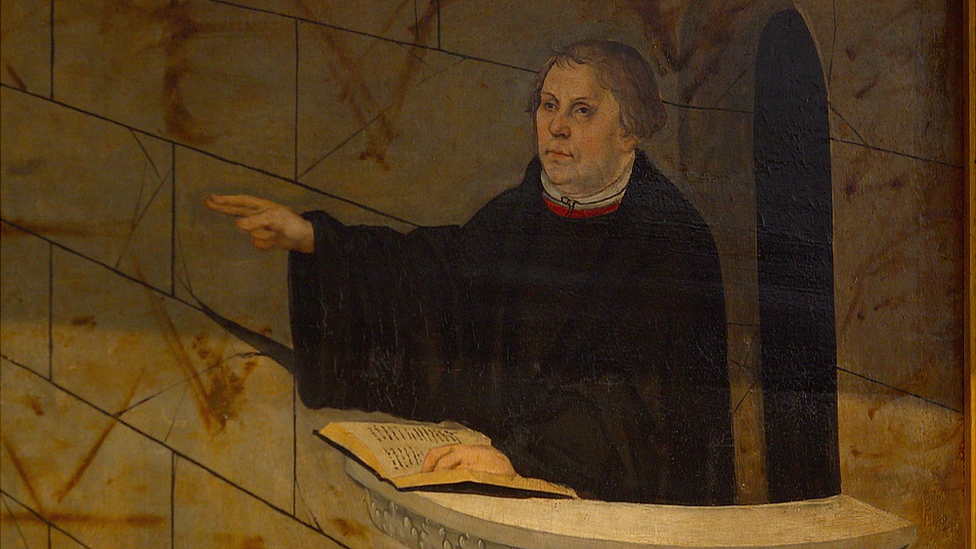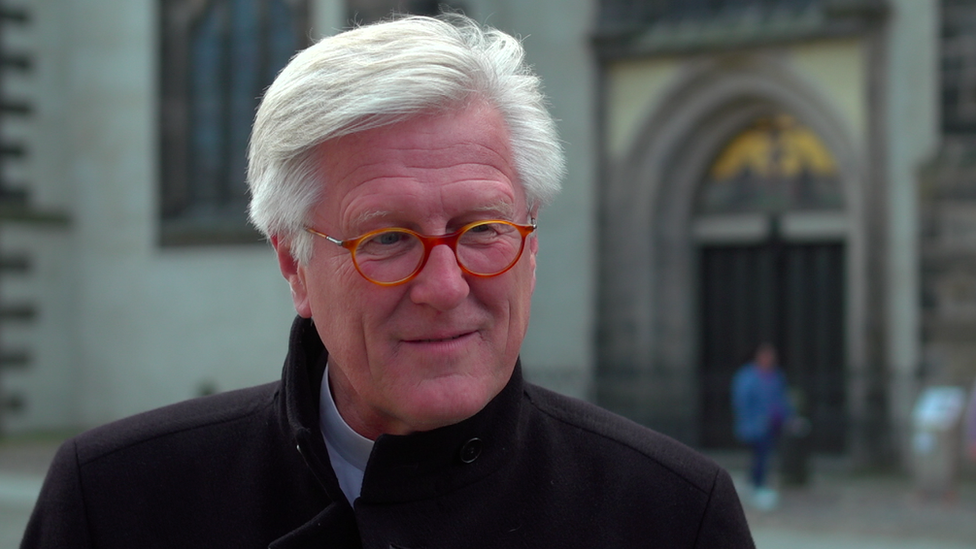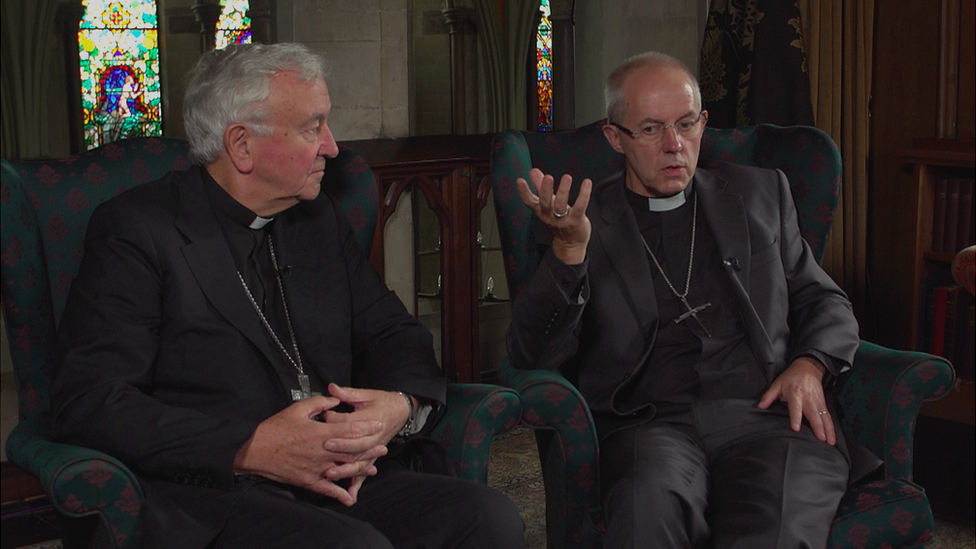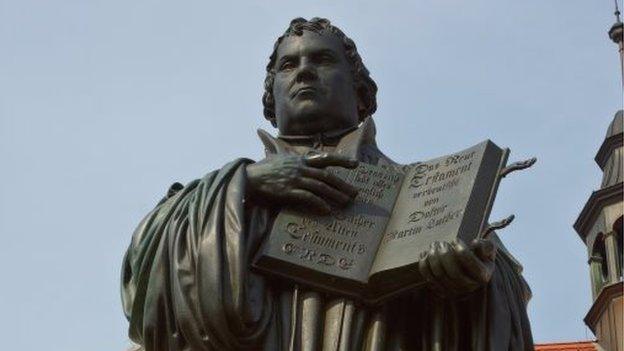The young man who shook the Catholic Church to its core
- Published

Martin Luther began the Protestant Reformation 500 years ago
Five hundred years ago, a young German monk began the Protestant Reformation, shattering the authority of the Catholic Church.
Centuries later, there are signs that the churches have put aside their differences.
I pray thee… go not to Wittenberg. (Hamlet Act I, Scene ii).
In an early scene from Shakespeare's play, Hamlet's mother Gertrude begs him not travel to Wittenberg.
She believes that her son's studies in a provincial German town on the banks of the River Elbe may be a threat to their security and the Catholicism of his upbringing.
She had good reason to be worried.
For that is precisely what happened when a monk called Martin Luther engaged in the concentrated study of scripture at the University of Wittenberg.
It would lead him to some Biblical beliefs - particularly the doctrine of justification by faith alone - that would transform Luther's understanding of church, God and eternal life.
It would also result in him hammering 95 theses - arguments and objections - to the doors of the Schlosskirche, or University church.
With each blow, the authority and stability of the Catholic Church was challenged as never before.

The door of the Wittenberg Schlosskirche, where Luther nailed his theses
"He wanted to rediscover Christ," says Heinrich Bedford-Strohm, Germany's most senior Protestant bishop, "and he fought against certain practices of the Church of his time."
"And since it was not possible to agree upon these things and to find a way forward to reform the Church, he started something new. And many people went with him," adds the bishop.
The anniversary of Luther's protest will be marked in Wittenberg on 31 October, 500 years after he hammered on the University church's doors.

What was the Reformation?
A religious movement which challenged the teachings of the Roman Catholic Church
Began in Germany in 1517 but soon spread through much of northern Europe
Held that salvation came by grace through faith alone, not by good works or deeds
Led to the creation of Protestant churches separate from the Roman Catholic Church
The Church of England broke from the Catholic Church later in the 16th Century

But this theological earthquake began a little earlier.
If Paul the Apostle was converted on the road to Damascus, then for Martin Luther it was thunder and lightening on the road to Erfurt.
Luther, aged 21, was returning to university having spent time visiting his parents in 1505.
As he walked, the heavens opened and a deluge of Biblical proportions rained down.
It provoked such fear and anxiety that he cried out to Saint Anne, the Virgin Mary's mother, promising that if he survived he would enter a monastery.
Two weeks later Luther was admitted to the house of Augustinian friars in Erfurt and the rest, as they say, is history.

Bishop Heinrich Bedford-Strohm: "Luther wanted to rediscover Christ"
Luther's theological crisis was accelerated by a Dominican monk called Johann Tetzel, who was charged with collecting so-called indulgences on behalf of the Catholic Church.
These were payments which were made in the hope that individuals, and their deceased relatives, would be fast-tracked through purgatory into heaven.
Tetzel was an effective travelling salesman.
He would ask his audience: "Don't you hear the voices of your wailing dead parents and others? From this you could redeem us with small alms."
He would even offer a jingle that would not be out of place in a modern advertising campaign: "When the coin in the coffer rings, the soul from purgatory springs."
But as Luther read the New Testament letter to the Romans, he was transfixed by the phrase "the righteousness of God".
He later explained his epiphany: "I began to understand that the righteousness of God is that by which the righteous lives by a gift of God, namely by faith."
Suddenly, Luther came to believe that one's acceptance before God could not be purchased by indulgences, nor achieved by good works, but only received through faith.
He also came to the conclusion that only scripture could determine the governance of the Church and the practice of Christians.
'Son of iniquity'
Luther's observations were not well received.
Within a year, Pope Leo X dismissed Luther as an outspoken drunk who would repent when sober, describing him as "a son of iniquity".
Excommunicated in 1521, Luther was dragged before the Diet of Worms, an assembly of the Holy Roman Empire, but refused to recant, uttering words which are now permanently linked to him: "Here I stand, I can do no other, God help me."
Before Luther could be punished, the territorial prince of Saxony, Elector Frederick the Wise, arranged for him to be smuggled away to his castle at Wartburg.
There he would spend a year translating the New Testament into German.
With the advent of the printing press, alongside Luther's translation, the word began to spread.

Tourists have flocked to Wittenberg to see Lucas Cranach's altarpiece
Luther's breakthrough led local artist Lucas Cranach to paint his friend, in disguise, alongside the disciples at the Last Supper.
The clear suggestion was that Martin Luther was much closer to the New Testament message than the Catholic Church.
But as the Reformation spread through Europe, it was marked by bloody episodes of warfare and violence.
Wars were waged in central, western and northern Europe from 1524 to 1649, fuelled by the religious rivalry that Luther had unwittingly inspired.
Eventually, the two Churches would co-exist peacefully, but without any formal links.
To mark the anniversary, we brought together the respective leaders of the Anglican and Catholic Churches in England.
Today, the Churches are arguably closer than at any point since the Reformation.
The leader of the Church of England, Archbishop of Canterbury Justin Welby, said: "It's unimaginable that 50, 60 years ago that the two of us should have sat doing an interview together."

Cardinal Nichols and the Archbishop of Canterbury agree relations are improving between Catholics and Protestants
Cardinal Vincent Nichols, the Archbishop of Westminster and leader of Catholics in England and Wales, also expressed relief that violence is no longer part of theological disagreement.
"I hope we will always maintain that mutual respect and freedom for religious expression in all its aspects," he said.
To demonstrate the setting aside of differences, an act of reconciliation will take place at Westminster Abbey on Tuesday.
Mr Welby will present copies of a text that seeks to resolve the dispute that erupted in Wittenberg.
Although the joint declaration has been signed by denominational leaders, many individuals within their Churches still do not agree and prefer to stick with their own traditions.
But they might consider the question asked by Pope Francis, when he visited the Lutheran Church in Rome two years ago.
In a brief homily, he asked: "If we have the same baptism, shouldn't we be walking together?"
- Published17 January 2017

- Published31 October 2016

- Published21 May 2015
